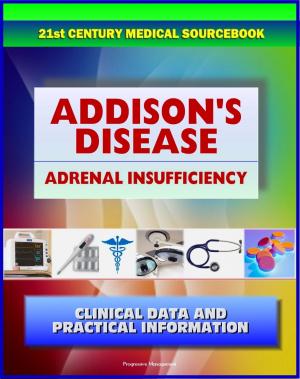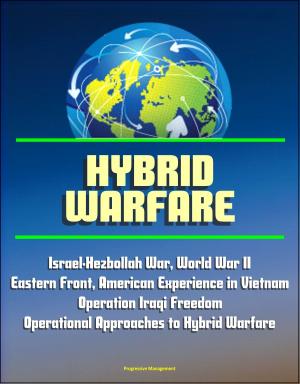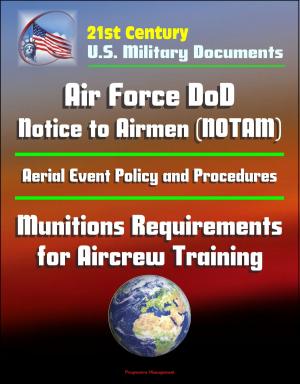Air Force Doctrine Document 3-70: Strategic Attack - Effects-Based Approach, Historic Attacks, Situation Development, Center of Gravity Analysis, Desert Storm, Milosevic, Command and Control
Nonfiction, History, Military, Strategy, Aviation| Author: | Progressive Management | ISBN: | 9781476015514 |
| Publisher: | Progressive Management | Publication: | April 19, 2012 |
| Imprint: | Smashwords Edition | Language: | English |
| Author: | Progressive Management |
| ISBN: | 9781476015514 |
| Publisher: | Progressive Management |
| Publication: | April 19, 2012 |
| Imprint: | Smashwords Edition |
| Language: | English |
This Air Force doctrine document (AFDD) establishes doctrinal guidance for the United States Air Force on strategic attack. It articulates fundamental Air Force principles for the application of combat force and provides commanders operational guidance on the employment and integration of Air Force resources to achieve desired objectives.
War is one of mankind's most complex endeavors. Destroying or incapacitating enemy military forces and attriting them into ineffectiveness is one means, but not the only means, of achieving warfare's objectives. Airmen have always envisioned going directly to the heart of an enemy. Modern air, space, and cyberspace power has come a long way toward realizing this vision. The combination of advanced systems with stealth and precision has made airpower a force to be reckoned with. Commanders now have the capability to directly affect an adversary's strategic center of gravity, helping to accelerate achievement of US national objectives.
Strategic attack is offensive action specifically selected to achieve national strategic objectives. These attacks seek to weaken the adversary's ability or will to engage in conflict, and may achieve strategic objectives without necessarily having to achieve operational objectives as a precondition. Strategic attack involves the systematic application of force against enemy systems and their centers of gravity, thereby producing the greatest effect for the least cost in blood and treasure. Vital systems to be affected may include leadership, critical processes, popular will and perception, and fielded forces. Strategic attack provides an effective capability that may drive an early end to conflict or achieve objectives more directly or efficiently than other applications of military power.
Air Force Doctrine Document 2-1.2, Strategic Attack, is doctrine for understanding, planning, and executing this crucial function across the range of military operations. Air Force personnel need to be able to articulate the rationale for strategic attack as an essential and valuable warfighting option for the combatant commander. More importantly, Air Force personnel must understand how strategic attack can help fulfill or enhance our national security and military strategies as a tool for defeating our nation's adversaries.
Contents: Chapter One - The Character of Public Affairs * Chapter Two - Principles, Competencies and Tasks * Chapter Three - Public Affairs Relationship to Information Operations * Chapter Four - Operational Engagement * Chapter Five - Public Affairs Readiness
This Air Force doctrine document (AFDD) establishes doctrinal guidance for the United States Air Force on strategic attack. It articulates fundamental Air Force principles for the application of combat force and provides commanders operational guidance on the employment and integration of Air Force resources to achieve desired objectives.
War is one of mankind's most complex endeavors. Destroying or incapacitating enemy military forces and attriting them into ineffectiveness is one means, but not the only means, of achieving warfare's objectives. Airmen have always envisioned going directly to the heart of an enemy. Modern air, space, and cyberspace power has come a long way toward realizing this vision. The combination of advanced systems with stealth and precision has made airpower a force to be reckoned with. Commanders now have the capability to directly affect an adversary's strategic center of gravity, helping to accelerate achievement of US national objectives.
Strategic attack is offensive action specifically selected to achieve national strategic objectives. These attacks seek to weaken the adversary's ability or will to engage in conflict, and may achieve strategic objectives without necessarily having to achieve operational objectives as a precondition. Strategic attack involves the systematic application of force against enemy systems and their centers of gravity, thereby producing the greatest effect for the least cost in blood and treasure. Vital systems to be affected may include leadership, critical processes, popular will and perception, and fielded forces. Strategic attack provides an effective capability that may drive an early end to conflict or achieve objectives more directly or efficiently than other applications of military power.
Air Force Doctrine Document 2-1.2, Strategic Attack, is doctrine for understanding, planning, and executing this crucial function across the range of military operations. Air Force personnel need to be able to articulate the rationale for strategic attack as an essential and valuable warfighting option for the combatant commander. More importantly, Air Force personnel must understand how strategic attack can help fulfill or enhance our national security and military strategies as a tool for defeating our nation's adversaries.
Contents: Chapter One - The Character of Public Affairs * Chapter Two - Principles, Competencies and Tasks * Chapter Three - Public Affairs Relationship to Information Operations * Chapter Four - Operational Engagement * Chapter Five - Public Affairs Readiness















